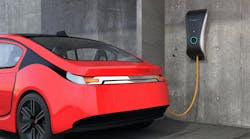I can be a bit of a stats geek at times, and some statistics I saw recently from the Energy Information Administration (EIA) on declining U.S. oil imports really made my day. They appealed to my interests in geopolitics, renewable energy alternatives — and new business opportunities for EW's readers.
The EIA says the United States relied on foreign oil for an estimated 45% of its net imports as a share of domestic consumption in 2011, down from 60% just six years earlier. A report published earlier this year by the Raymond James investment and advisory firm said imports of foreign oil could fall further to 4.5 million barrels a day — just a quarter of domestic oil demand by 2015.
The report also said because of increases in domestic oil and natural gas production, new fuel-efficiency standards for cars and increases in power generated by renewables, the United States may not have to import oil anymore by 2020. Pavel Molchanov, one of the report's authors, told Dow Jones News Services, “Domestic oil demand will be entirely met by domestic oil supply for the first time since World War II. This scenario would be historic, epic, a big deal.”
Even if that scenario turns out to be a bit too bullish, there's no denying sweeping changes are underway in how the world produces its power. That's good news for all sorts of reasons. It would certainly change our economic relationships with trading partners in the Middle East and Latin America, and lessen the economic impact of any future disruptions in supply or oil embargoes. This could make some of the shakier political regimes now milking their oil-based economies a whole lot less important on the world stage.
New extraction techniques, including hydraulic fracturing, or “fracking,” have unlocked resources that for years were too expensive tap, and are having a direct impact on companies in the electrical industry. Distributors that do business with companies utilizing this new technology in North Dakota's Bakken region have seen big-time increases in their sales as they service the surge in related electrical construction and MRO business. One industry observer called the Bakken bonanza a “once-in-a-career” type of sales opportunity. And distributors in eastern Ohio and western Pennsylvania have told us the Marcellus shale deposit in their region is fueling some nice pops in sales.
Outside the United States, Canadian distributors in Alberta's oil sands region have been running flat out to keep pace with energy-related business. One big reason WESCO Distribution Inc., Pittsburgh, purchased Brews Supply, Calgary, Alberta, last year was its relationships with the region's energy companies.
Another massive energy-related project with direct impact on the electrical business are the Lula oil fields off Brazil's coast, said to be the largest oil discovery in the Western Hemisphere in the last 30 years. In the past two years, several distributors, including Rexel, Sonepar and the Electrical Distributors Global Enterprise (EDGE) distributor group, have acquired Brazilian distributors to get in on some of the anticipated action.
And no matter where you stand on renewables or the debate over the extension of Production Tax Credit, you can't overlook the fact that wind farms are producing real power for the U.S. economy, and real sales for some electrical companies. The American Wind Energy Association (AWEA), Washington, D.C., says wind farms in the United States recently hit a historic milestone — 50 gigawatts (GW) of electric generating capacity. AWEA says bringing those 50GW online means U.S. wind turbines now power the equivalent of nearly 13 million American homes, and “represents the generating power of 44 coal-fired power plants, or 11 nuclear power plants.”
The wind industry is big business in the United Kingdom, too. According to London-based RenewableUK, the trade group for the UK's wind and marine renewables industries, the country's 1,233 offshore turbines either already installed or under construction will soon be producing 2,359 MW — approximately 1.5% of its power today; other offshore wind farms now on the drawing boards would raise this percentage to 17% in 2020.
Despite all the uncertainty about the upcoming elections and sluggish economic recovery, there really is some good news out there. Next time you need a little pick-me-up, Google around for a little oil import data. It may make your day.










